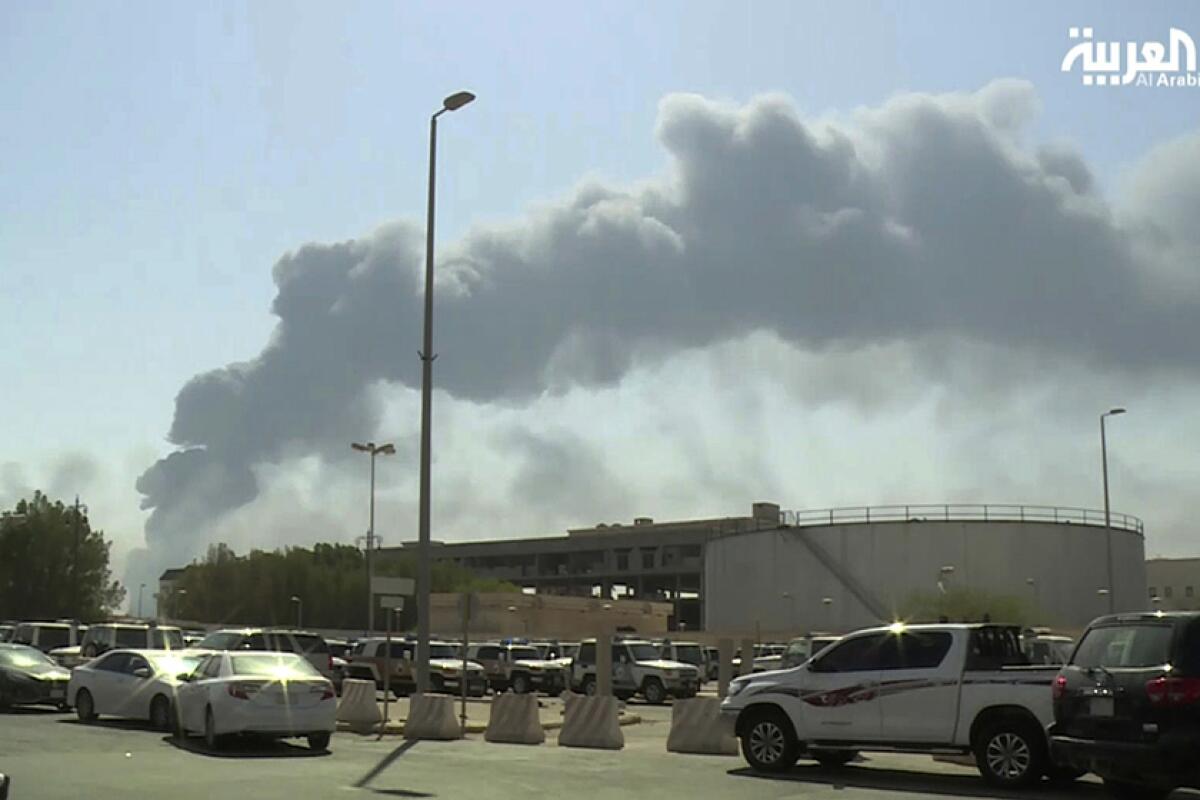Column: The U.S. has Iran cornered, and that’s part of the problem

WASHINGTON — Almost 800 years ago, the Persian poet Sa’adi offered a useful warning:
Do you not see how the cornered cat
Will tear out the eyes of a leopard with its tiny claws?
In today’s Middle East, Iran — besieged by the more powerful United States, its economy in tatters, its military stretched thin — is playing the role of the cornered cat.
We still don’t know who fired the missiles that knocked much of Saudi Arabia’s oil infrastructure out of commission last weekend. But it appears likely that Iran supplied the weapons, and that whoever launched them was at least a client of Tehran. Either way, Iran’s fingerprints were present.
So it’s worth asking: Why would Iran take such a risk? What message were Tehran’s rulers sending?
Of all the mysteries surrounding the attacks, that’s the easiest to figure out: Don’t tangle with a cornered cat. You may win, but you won’t come away unscathed.
“We have backed Iran into a corner by blocking the sale of their oil,” John Limbert, a former U.S. diplomat in Iran, told me. “We’ve put them in a position where they have nothing to lose. We shouldn’t have been surprised if they lashed out.”
Four years ago, when Barack Obama was president, Iran agreed to dismantle much of its nuclear program in exchange for an end to most international economic sanctions. But in 2018, Trump abandoned the agreement, imposed new sanctions, and threatened to crush Iran’s economy unless Ayatollah Ali Khamenei agreed to a long list of demands.
Iran’s response was predictable: It denounced the new sanctions as “economic warfare,” which was true. It tried to evade the oil embargo with European help. When Europe didn’t deliver, Iran looked for other ways to strike back.
“If the United States decides to block Iran’s oil, no oil will be exported from the Persian Gulf,” Iranian President Hassan Rouhani warned last year.
In May and June, four oil tankers in the Persian Gulf were sabotaged in covert attacks that appeared to come from Iran. Those incidents aroused widespread condemnation; the safety of international shipping is a basic principle in foreign affairs.
The air attacks on Saudi oil facilities were more pointed — and perhaps more deniable. Yemen’s Houthi rebels, who have been under attack by Saudi Arabia for four years, claimed responsibility. The Houthis are supplied and supported by Iran, but they often act independently.
The 17 strikes made clear that if the United States and Iran go to war, Saudi Arabia’s surprisingly vulnerable energy infrastructure, which is crucial to the global economy, would be one of the first victims.
This isn’t an apology for Iran’s aggressive foreign policy or its repressive domestic system. It’s merely an explanation of Iran’s behavior, which is thoroughly objectionable — but hardly inscrutable.
President Trump’s strategy of “maximum pressure” has worked; it has brought Iran’s economy to its knees. But it has also produced a larger crisis, thanks to Iran’s unsurprisingly bellicose response.
Now Trump is under pressure to retaliate for the attacks if Iran’s authorship becomes clear.
But both sides say they would prefer diplomacy to war. “I know that they want to make a deal,” Trump said Monday.
The president has sent a series of invitations to Rouhani proposing a quick summit meeting, much like the three encounters he has staged with North Korea’s Kim Jong Un. The White House hoped to arrange a meeting on the sidelines of the United Nations General Assembly in New York next week.
But the invitations misfired. Both Rouhani and his boss, Khamenei, have consistently said they’re not interested in a splashy, televised summit.
They’re not looking for a North Korea-style bromance, with gauzy professions of goodwill and friendship. That would not play well for Rouhani in the cutthroat politics of Tehran — a basic fact that Trump seems not to have absorbed from his intelligence briefings.
Still, the Iranians have said they’re open to talks at a lower level, but only if the United States lifts the economic sanctions and returns to the 2015 nuclear deal.
“They’re going to want at least a clear promise of sanctions relief,” Limbert said. “They’re going to play hard to get. That’s one of their few bits of leverage.”
Now that Iran seems to have made its point, is there a way both sides can be persuaded to deescalate?
One way would be for a go-between like French President Emmanuel Macron to arrange a meeting, even if it’s not at the level of both presidents. Macron tried to broker a summit meeting last month, but the Iranians balked — and Trump apparently didn’t want to share the spotlight with Macron.
Another, proposed by former CIA official Bruce Riedel, would be for the United States to call for a ceasefire in Yemen, followed by an international conference that would provide an indirect way to talk to Iran.
Amid all the talk of war, there’s still an opportunity for diplomacy — if the hardliners in both Washington and Tehran would just get out of the way.
More to Read
Get the L.A. Times Politics newsletter
Deeply reported insights into legislation, politics and policy from Sacramento, Washington and beyond. In your inbox three times per week.
You may occasionally receive promotional content from the Los Angeles Times.











